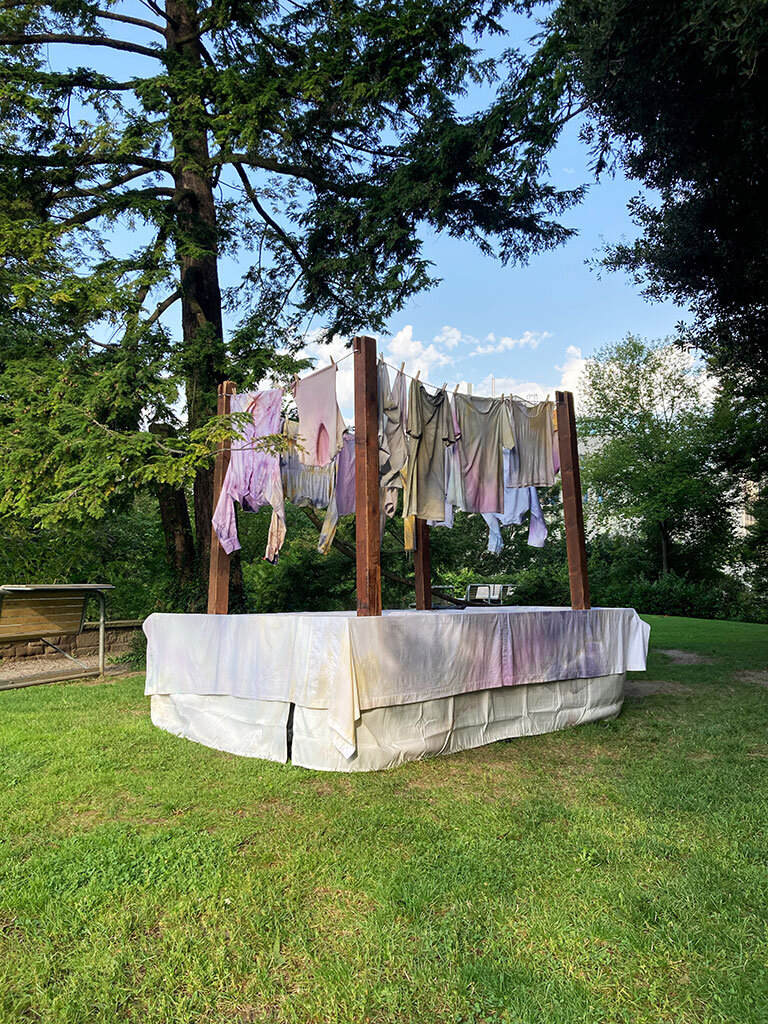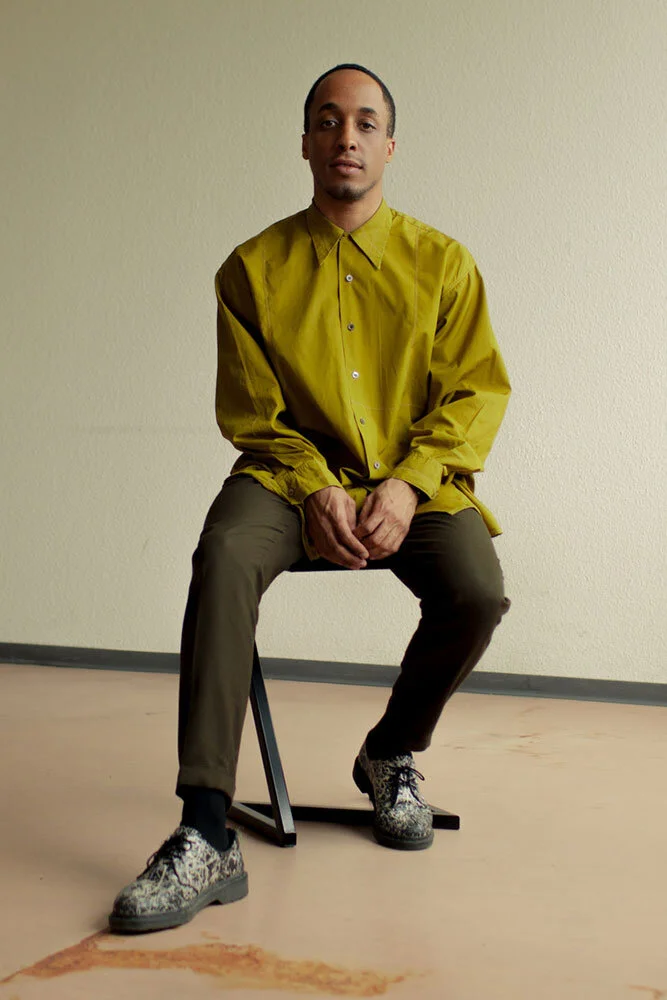CROCODILE TEARS WON’T STOP CLIMATE CHANGE / Part. 02 – Rafael Kouto
CROCODILE TEARS WON’T STOP CLIMATE CHANGE / Part. 02
Rafael Kouto
….
Rafael Kouto schafft ein futuristisches Szenario um über soziale Folgen von Pandemie und Klima zu reflektieren. Der Akt des Wäschewaschens, im Kontext von Färbetechniken afrikanischer Kulturen und dem klimabedingten Schmelzen der Gletscher wird zur zentralen und sozialen Aktion. In Kollaboration mit Alonso Studio, Sound Installation by Black Fluo.
CROCODILE TEARS ist eine lebendige Installation. Geometrische Elemente aus Eis und Textilfarbpigmenten liegen auf Gewebe, das gefärbt wird, sobald das Eis schmilzt. Die Installation symbolisiert den Dorfbrunnen, ein in vielen Kulturen seit Jahrhunderten zentraler Treffpunkt um gemeinsam Wäsche zu waschen und Textilien zu färben.
In Koutos Projekt trifft man sich für die «Melt and Dye»-Aktivität und um gleichzeitig zu sehen, wie das gefärbte Eis der Gletscher infolge der Klimaerwärmung schmilzt und die Welt verändert. Die Installation verändert sich fortlaufend. Das geschmolzene Eis färbt die Textilien für immer. Die Textilien zeigen Spuren des natürlichen aber unumkehrbaren Prozesses auf.
Rafael Kouto will mit dieser Installation demonstrieren, dass gemeinschaftliches Arbeiten öffentlich zugängliche und nutzbare Räume braucht. Es ist ein Plädoyer für das Pflegen von Beziehungen durch gemeinsame Tätigkeiten – gerade in Zeiten der Pandemie wird bewusst wie wertvoll dies ist, um den Zusammenhalt der Gesellschaft zu stärken.
Die Besuchenden sind eingeladen, eigene gebrauchte Kleidung am Eröffnungsabend mitzubringen um sie färben zu lassen. Abholen kann man die gefärbten Kleider am Folgetag.
In dieser Installation führt Kouto die «Melt and dye»-Drucktechnik fort, die er im Spazio Lampo in Chiasso, kuratiert von Carolina Sanchez, dieses Jahr erforscht hat. Anleihen nimmt er auch bei seinen vorherigen Kollektionen «Suspended bodies that will never fall», 2019, und «Wishing that this world will last forever», 2020, die das Phänomen der globalen Erwärmung betonen und sich auf das Schmelzen der Gletscher konzentrieren.
SPECIAL PROGRAM
12. August 17:00 – 21:00
Textilfärben am Opening
..
Rafael Kouto creates a futuristic scenario to reflect on the social consequences of pandemic and climate.
The act of washing clothes, in the context of dyeing techniques of African cultures and the climateinduced melting of glaciers, becomes a central and social action. In collaboration with Alonso Studio, sound installation by Black Fluo.
CROCODILE TEARS is a living installation. Geometric elements made of ice and textile pigments lie on fabric that is dyed as the ice melts. The installation symbolizes the village fountain, a central meeting place in many cultures for centuries to do laundry and dye textiles together.
In Kouto's project, people gather for the “melt and dye” activity and at the same time to see how the dyed ice of the glaciers melts as a result of global warming and changes the world. The installation is continuously changing. The melted ice dyes the textiles forever. The textiles show traces of the natural but irreversible process.
Rafael Kouto wants to demonstrate with this installation that collaborative work needs publicly accessible and usable spaces. It is a plea for nurturing relationships through shared activities - especially in times of pandemic, one realizes how valuable this is in strengthening the cohesion of society.
Visitors are invited to bring their own used clothing to be dyed on the opening event. The dyed clothes can be collected the following day.
In this installation, Kouto continues the “melt and dye” printing technique he explored this year at Spazio Lampo in Chiasso, curated by Carolina Sanchez. He also borrows from his previous collections, “Suspended bodies that will never fall”, 2019, and “Wishing that this world will last forever”, 2020, which emphasize the phenomenon of global warming and focus on the melting of glaciers.
SPECIAL PROGRAM
12. August 17:00 – 21:00
Textile dyeing at the Opening
….
Fragebogen..Questionary
….
Ist Design systemrelevant?
Ja, Design kann Alternativen zeigen zu einem bestehenden System, kann aber auch Selbstzweck und dann irrelevant sein.
Wo CLASHT es in Deiner Arbeit?
Beim zweiten Blick! Er ist immer voller Spannung, Verärgerung, Neugier, Neuheit, Überraschung, Missverständnis, Unwissenheit bei der Frage nach dem Ursprung und der Herkunft dahinter.
Wie sieht bei Dir ein normaler Designprozess aus?
Der kreative Prozess beginnt für mich mit der Frage, wie Einschränkung das Design beeinflusst.
..
Is design relevant to the system?
Yes, design is about creating alternatives and counterpart systems to it, otherwise design as an end in itself is irrelevant.
Where does it CLASH in your work?
The first look always goes unnoticed but the second look is always full of tension, annoyance, curiosity, novelty, surprise, misunderstanding, ignorance in questioning the origins and provenance behind it.
What does a normal process look like for you?
The first question to start the creative process for me is about how limitation influences design?
….
Über..About
….
Rafael Kouto ist Creative Director der gleichnamigen Couture Marke, die er 2017 gründete. Er konzentriert sich auf Upcycling-Methoden und nachhaltige Strategien mit einem besonderen Fokus auf Open Source und Handwerkskunst. Er unterrichtet an verschiedenen Institutionen und als Professor an der IUAV in Venedig.
..
Rafael Kouto is Founder and Creative Director of the eponymous upcycling couture brand, founded in 2017, focuses on upcycling methods and sustainable strategies with a particular focus on open source and craftsmanship. Dedicated to the engagement of this practice also through workshops and engaging strategies at various institutions and as a professor at the IUAV in Venice.
….
Curators’ Comment
….
Rafael Kouto sieht sich als Hersteller von Kleidern in der Pflicht, einen gesellschaftlichen Wandel anzustreben und eine Transformation des Fashion-Konsums herbeizuführen. Dabei kritisiert er nicht nur die Fast-Fashion, sondern bietet mit seiner Installation im Alten Botanischen Garten einen Umgang mit mitgebrachten Altkleidern. Die Designleistung geht über das klassische Modedesign hinaus und integriert Kreisläufe, Methoden und Handlungsfelder. Rafael zeigt uns Möglichkeiten der Transformation auf und regt einen Wandel an. (Andreas Saxer)
..
As a manufacturer of clothes, Rafael Kouto sees it as his duty to strive for social change and to bring about a transformation of fashion consumption. In doing so with his installation in the Old Botanical Garden, he not only criticizes fast fashion, but also offers a way of dealing with old clothes that have been brought along by the visitors. The design performance goes beyond classic fashion design and integrates cycles, methods and fields of action. Rafael shows us possibilities of transformation and encourages change. (Andreas Saxer)
….



